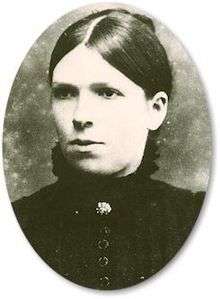Wil van Gogh
| Wil van Gogh | |
|---|---|
 Wil van Gogh in c. 1880 | |
| Born |
Wilhelmina Jacoba van Gogh 16 March 1862 Zundert, Netherlands |
| Died |
17 May 1941 (aged 79) Ermelo, Netherlands |
Wilhelmina Jacoba "Wil" van Gogh (Dutch pronunciation: [ʋɪlɦɛlˈminaː jaːˈkoːbaː ʋɪl vɑn ɣɔx]; 16 March 1862 – 17 May 1941)[1] was a nurse and early feminist. She is best known as the youngest sister of the artist Vincent van Gogh and the art dealer Theo van Gogh.[2]
Life
Wilhelmina Jacoba van Gogh was born on 16 March 1862 in Zundert in the Netherlands, daughter of Theodorus van Gogh and Anna Cornelia Carbentus. She had three brothers Vincent, Theo, and Cor, and two sisters Elisabeth and Anna.
During the first part of her life Wil van Gogh served her family and others, nursing the sick. After the death of her brothers in 1890 and 1891, she obtained a modest job in a hospital. There she engaged in the committee to organise the "National exhibition of women's work" (Nationale Tentoonstelling van Vrouwenarbeid), 1898. This was a highly successful enterprise and funds raised from the exhibition, 20,000 Dutch guilders, served to establish the Dutch national bureau for women's work.
No sources record what happened, but on 4 December 1902 Wil van Gogh was interned and later transferred to the House Veldwijk, a psychiatric institution at Ermelo. The diagnosis of dementia praecox, on which this measure was based, was at the time considered a fatal illness. Asylum records later noted:
'"There has been no significant change in the condition of this long-standing patient. She remains solitary and withdrawn, rarely speaks and generally does not respond to questions. She spends her entire day in the same place in the lounge, sitting in her chair and gazing blankly at her surroundings. She has refused food for years and has to be fed artificially ...'"[3]
Wil van Gogh remained at Ermelo for almost four decades before she died there on 17 May 1941.
Whether she was mentally ill or not is nowadays difficult to prove.[4] Renate Berger asserts that Wil van Gogh shared the fate of many "sisters of well-known men" at the time.[3][5]
Notes
- ↑ Correct name and dates according to Nederland's Patriciaat 50, 1964, p. 182
- ↑ "Biographical & historical context: The immediate family circle". Vincent van Gogh: The Letters. Van Gogh Museum.
- 1 2 Visser, Yuri (April 2003). "Willemina Jacoba van Gogh" (in Dutch). Het Kontakt (archived vggallery.com).
- ↑ Angier, Natalie (21 December 1991). "New Explanation Given For van Gogh's Agonies". New York Times.
- ↑ Berger 1985
References
- Anonymous (initialled "H.H.H." and "W.F.d.C.H."): Van Gogh, 's-Gravenhage, Nederland's Patriciaat 50, 1964, pp. 171–183
- Berger, Renate: Willemina Jacoba van Gogh (1862–1941): "Du bist sehr tapfer, liebe Schwester", in: Schwestern berühmter Männer. Zwölf biographische Porträts, ed. Luise F. Pusch, Insel, Frankfurt am Main, 1985, pp. 453–485 ISBN 3-458-32496-8
External links
| Wikimedia Commons has media related to Wil van Gogh. |
- Yuri Visser: Willemina Jacoba van Gogh, in Dutch
- Vincent van Gogh: Portrait of Willemina